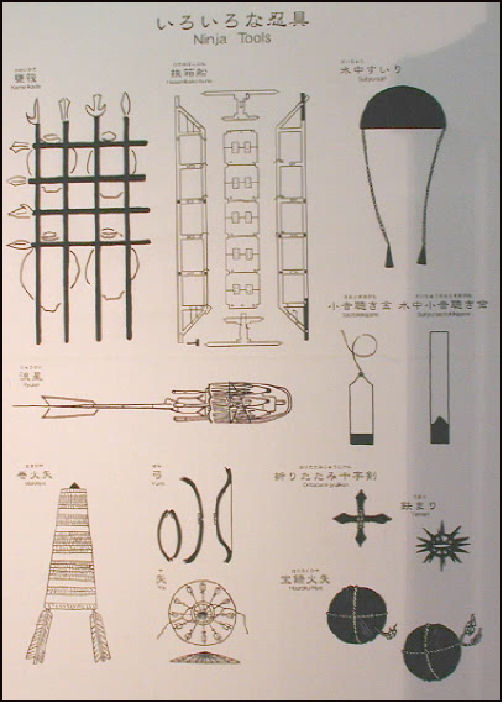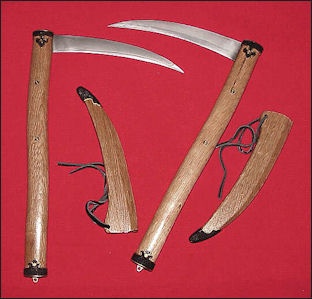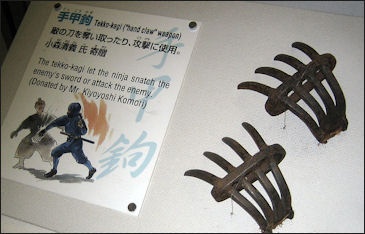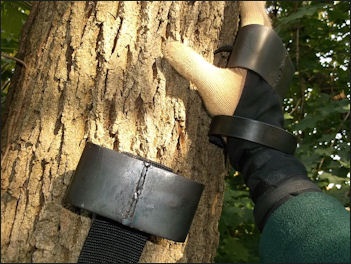NINJA STEALTH AND CAMOUFLAGE

Hokusai sketch of a ninja in a 19th century manga
Ninjas were trained from an early age to walk and move quietly. They communicated with secret codes and used aliases instead of their real names. Before going on missions they avoided eating garlic and beans to reduce the chance of producing odors that might draw unwanted attention.
Ninjas were skilled at scaling castle walls and using well tunnels to pop up in unlikely places. Their ability to disappear is attributed to their use of trapdoors in floors and secret pivotal doors in walls. Their residences had hidden escape routes and movable floorboards where their weapons and swords were stashed.
Contrary to myth, ninja men did not dress in hooded black jumpsuits. Rather they wore conservative blue outfits like those worn by peasants that allowed them to blend into the crowd. When they traveled they often posed as Buddhist priests or candy salesmen. Women ninjas were rare and didn't wear red costumes.
According to the Ninja Museum of Igaryu: “When not working, ninja lived the same lives as farmers. When they went about their work, they used to camouflage, so as not to be revealed as ninja to those around them. When they traveled along roads, they changed their appearance from that of commoners and farmers to medicine peddlers or mountain monks, changing between clothing that suited the situation. In traditional Ninja writings, there was a camouflage method known as Shichihoude, which was divided into the seven types of disguises: monk, priest, mountain monk, merchant, minstrel, and performer. What, then, was a ninja’s outfit? Actually, it was a mask used by farmers in the Iga region, and was worn when working at night. This clothing allowed one to blend into the night. [Source: Ninja Museum of Igaryu, Igaueno Tourist Association iganinja.jp]
Good Websites and Sources: Iga-ryu Ninja Museum site iganinja.jp ; Wikipedia article on Ninjas Wikipedia ; About.com on Ninjas asianhistory.about.com
RELATED ARTICLES IN THIS WEBSITE: SAMURAI, MEDIEVAL JAPAN AND THE EDO PERIOD factsanddetails.com; DAIMYO, SHOGUNS AND THE BAKUFU (SHOGUNATE) factsanddetails.com; SAMURAI: THEIR HISTORY, AESTHETICS AND LIFESTYLE factsanddetails.com; SAMURAI CODE OF CONDUCT factsanddetails.com; SAMURAI WARFARE, ARMOR, WEAPONS, SEPPUKU AND TRAINING factsanddetails.com; FAMOUS SAMURAI AND THE TALE OF 47 RONIN factsanddetails.com; NINJAS IN JAPAN AND THEIR HISTORY factsanddetails.com; WOKOU: JAPANESE PIRATES factsanddetails.com; MINAMOTO YORITOMO, GEMPEI WAR AND THE TALE OF HEIKE factsanddetails.com; KAMAKURA PERIOD (1185-1333) factsanddetails.com; BUDDHISM AND CULTURE IN THE KAMAKURA PERIOD factsanddetails.com; MONGOL INVASION OF JAPAN: KUBLAI KHAN AND KAMIKAZEE WINDS factsanddetails.com; MUROMACHI PERIOD (1338-1573): CULTURE AND CIVIL WARS factsanddetails.com; MOMOYAMA PERIOD (1573-1603) factsanddetails.com
RECOMMENDED BOOKS: “Secrets of the Ninja” by Hiromitsu Kuroi Amazon.com; “Ninja Attack! “ by Matt Alt and Hiroko Yoda. Amazon.com; “Ninja: 1,000 Years of the Shadow Warrior (P.S.)” by John Man Amazon.com; “The Book of Ninja: The Bansenshukai” - Japan's Premier Ninja Manual by Antony Cummins and Yoshie Minam Amazon.com; “Samurai and Ninja: The Real Story Behind the Japanese Warrior Myth that Shatters the Bushido Mystique” by Antony Cummins Amazon.com; Amazon.com; “Samurai: An Illustrated History” by Mitsuo Kure Amazon.com; “Samurai: A History (P.S.)” by John Man Amazon.com; “The Way of the Samurai” (Arcturus Ornate Classics) by Inazo Nitobe Amazon.com
Ninja Clothing, Food and the 60 Kilogram Weight Limit

Hokusai sketch of a ninja
According to the Ninja Museum of Igaryu: “ Ninja clothing was made to be light and prevent the wearer from being noticed. Black ninja clothing is often seen in movies, but there was actually no jet-black clothing. Jet-black would cause the form to stand out in the light of the moon, so a dark navy blue dying method was usually used. This navy blue dye fulfilled a function of being a sort of viper pattern, much like the rattlesnake-like pattern in the color of jeans. [Source: Ninja Museum of Igaryu, Igaueno Tourist Association iganinja.jp]
“When people imagine ninja, they often think of “running fast”, or “ability to fight”, or “powerful”, so there is a rather muscular, large image. However, if you think about the following, that mage might change somewhat. Ninja performed espionage in attics and under floors, made deft movements, and practiced camouflage, among other things. These would be tough to do with a large body, wouldn’t they?
“Because of their work on roofs, ninja had to constantly have tempered fingers. To train, they are said to have used bales of rice. These bales weighed about 60kg. In other words, to be able to lift 60 kilograms in training is to be able to lift oneself, including hanging from ceilings. Another thing is that if his name is any indication, Shotoku Taishi’s right hand man Otomono Sahito was probably slim, giving ninja that characteristic. This is because “Sahito” literally means “slim person”.”
There are portable foods used by travelers such as dried rice, but there were also portable foods particular to the ninja. These included: 1) the “thirst ball”, which helped hold back thirst and was made from crushed plum pulp, put with rye ergot (a fungus that grew on grass) and crystallized sugar, and made into a ball; 2) the “hunger ball”, which helped hold back hunger and was made with carrots, buckwheat flour, wheat flour, yam, licorice root, and rice flour steeped in sake for three years. When the sake had dried, the mixture was balled in about the size of a peach pit and ready for use.
For health, ninja avoided meat, fish, dairy foods, and sugars in favor of a diet centered on whole-grain rice and vegetables. Also, to avoid being detected when sneaking or hiding, they avoided foods that might lead to body odor. However, they did not avoid these foods completely, but seem to have eaten some foods for strength as well. The main food eaten were: millet, whole-grain rice, wheat, other grains, potatoes, mushrooms, mulberries, oleaster, chestnuts, sweet chestnuts, nutmeg, and pine nuts and quail eggs.
Ninja Breathing Walking and Running Methods

Hokusai sketch
Ninja espionage was primarily composed of intelligence gathering and message transmission. To do this effectively, ninja had to move quickly over long distances, walk quietly enough to sneak into places and to transmit information quickly. [Source: Ninja Museum of Igaryu, Igaueno Tourist Association iganinja.jp ]
There were five defined skills for walking, each used in different situations, with both “Kitsune-bashiri” (fox running) and “Shinso Usagi-aruki” (deep grass rabbit walking) allegedly making no sound. The five are: 1) “Shinobi-ashi” (quiet feet): gradually lowering one’s weight to the floor beginning with the small toes; 2) “Uki-ashi” (floating feet): lowering the feet from tiptoes; 3) “Inubashiri” (dog running): walking on all fours in a place where one cannot stand; 4) “Kitsune-bashiri” (fox running): walking on the tips of all fours in a place where one cannot stand; 5) “Shinso Usagi-aruki” (deep grass rabbit walking): walking on the backs of hands, carrying the feet in hands.
According to the Ninja Museum of Igaryu: “ Running skills were for rapidly transmitting information. Ninja were also called “people with fast feet” for their famed speed. For example, the ninja Idaten is said to have been able to run 200 kilometers in a single day. Running fast is possible mainly through training, but there were also secret skills and information for doing so.”
The breathing method called “dual breathing” required breathing in a repeated rhythm of “inhale - exhale - exhale - inhale - exhale - inhale - inhale - exhale”. Doing this is said to have increased intake of the oxygen and help a person to focus and run without thinking of other things. Ninjas were also taught, it was important to look far ahead when running and keep the chin down. When the chin goes up, it was reasoned, breathing would be impaired. Some ninja placed a pickled plum in their navel. This was probably a way of self-suggesting that “I can run fast”.
Ninja Training
Ninja training included instruction in esoteric Buddhism, Chinese yin and Yang philosophy, mountain asceticism, herbal medicine, psychology, astronomy, magic, pharmacology and fortunetelling. Some believe that the spiritual training by ninjas gave them the power to disappear, if you believe the films, in a puff of smoke.
Ninjas did a lot of physical training and tried to keep their body weight around 60 kilograms. They lifted 60-kilogram rice bags with one hand for strength, sprinted at great speeds backwards and sideways, and trained hard to develop skills in climbing, jumping, swimming, moving through difficult terrain. Finger strengthening exercises were done so they could hang from trees and walls for hours. They were forbidden from eating meat and ate unmilled brown rice to boost their concentration.
John Man told Time magazine: “ There was never any sort of formal martial training. It would have been from childhood, within the family, learning self-defense. The only formal training I’ve heard of was with the shugendo ascetics who were not ninja. And not all ninja underwent shugendo training.” So is this more of a spiritual process than a martial one? “It was both. Certainly it was spiritual. It was martial in so far as it trained you. There were no martial arts involved, but clearly if you can survive sitting under waterfalls or walking many miles in forests in extreme adversity, it helps you in your training to be a fighting spy. [Source: Ishaan Tharoor, Time, February 4, 2013;“Ninja: 1,000 Years of the Shadow Warrior” by John Man]

Ninja tools
Ninja Technology and Codes
Among the weapons used by ninjas were disguised knives and swords, metal claws, spiked devises that pierced the feet of pursuing enemies, and 30 different kinds of deadly shuriken (throwing knives). Despite their reputation for stealth, ninjas were not shy about using noisy weapons. They also employed arrow-mounted-rockets, smoke pots, rifles and portable cannons that shot gravel and iron chips. Star- and swastika-shaped shuriken were often tipped with poison.
Smoke was used in a number of ways by ninjas: as a signal the start of a battle or operation; as a diversion for disappearances and escapes. Ninjas also mixed smoke with poisons to make breathing difficult for their opponents. Their use of hidden traps was equally diabolical. A diagram from a ninja training manual shows a staircase that leads in the dark to a dead end, with a hidden pit whose floor is covered with spikes.
Among the other devices used by ninjas were special pipes that allowed them to listen to conversations in adjacent rooms, bamboo sticks used for scaling walls, sophisticated lock picks, foot-mounted floats used to traverse swamps, and grass rakes that could be used to scale walls or kill an opponent. When they were on the road ninjas subsisted off katayaki, dense, calorie-filled cookies. Some carried a compass-like magnet that always pointed south when placed on water, pistols disguised as short swords, and “portable” miniature cannons constructed to pass as vases.
When ninja wrote secret letters, they used special characters that only they could read in order to make the letters unreadable to others. “Shinobi Iroha” and “Jindai Moji” characters used the symbols for wood, fire, earth, gold, water, person, body (composed of the 5 Chinese characters + person and body) and matched them with the characters: color, blue, yellow, red, white, black, purple. According to the Ninja Museum of Igaryu: “ One explanation holds that these characters were used even prior to the bringing of Chinese characters to Japan, and they appear squiggly like a snake.” [Source: Ninja Museum of Igaryu, Igaueno Tourist Association iganinja.jp ]
Ninja Farmer Tool-Weapons

Kamas (farmer' sickle)
Ninja rarely carried the famous shuriken (ninja stars) because if they were stopped for identification and inspection while traveling and found to be carrying them, the shuriken would give away their identity as ninja. Therefore, weapons which could be carried without causing suspicion — namely farm implements — were favored by ninja. [Source: Ninja Museum of Igaryu, Igaueno Tourist Association iganinja.jp]
Ninja farmer tool-weapons included: 1) Kama (Sickle): Uses as Farm implement: Tool for grass cutting, rice harvesting. Uses as a weapon: Cutting, tying a rope to the handle and using it to climb to high places, other uses. 2) Tebo (Staff): Uses as Farm implement: Tool for taking the grain off rice stalks. Uses as a weapon: Swung about as with nunchaku. 3) Gotoku (Trivet): Uses as Farm implement: Used to lift heated iron kettles. Uses as a weapon: Used to take the legs out, and the outside edges were sharpened to act as a shuriken.
4) Hibashi (Fire tongs): Uses as Farm implement: Used to hold hot coals. Uses as a weapon: Swinging, throwing. 5) Ryuta or Kaginawa (Grappling hook): Uses as Farm implement: Used to lift dropped items out of wells. Uses as a weapon: used to hook an enemy. 6) Ashikagi (Foot hooks): Uses as Farm implement: Used to walk on slippery surfaces. Uses as a weapon: Used to kick, stomp on enemy. 7) Manto (Pruning shears): Uses as Farm implement: Used to trim plants. Uses as a weapon: Swung about. 8) Kadoyubi/tekagi (Finger spikes/hand hooks): Uses as Farm implement: Rice harvesting, grass cutting. Uses as a weapon: Worn on fingers and used to attack enemy.
Other representative items include: Makibishi: Sharp items scattered on the road during escape to hamper pursuers; Kunai: Blade tool used to dig dirt; Tsubokiri: Two-pronged blade used to open holes in the ground; and Shikoro: Blade used to cut trees. There are several others as well.
Ninja Weapons and Skills Using Weapons

Shuriken (ninja star) includes both flat and cylindrical varieties. They came in various shapes,with four, five, six, seven, or eight sides. The points were as sharp as a sword but were short and thus unable to inflict a fatal wound. Their potential to kill could be enhanced by placing poison on the tips. Other tricks of the trade included placing slow-burning matches on a flat shuriken to throw at the enemy; throwing metal cones with flat shuriken placed on them; and 3) holding shurkien in one’s hand and using it like a spiked brass knuckles. However, as said before, being caught with such devices would arouse suspicion, so ninja often used pegs and sewing needles for the same purposes. [Source: Ninja Museum of Igaryu, Igaueno Tourist Association iganinja.jp]
Ninjas using shuriken aimed for the head. Shuriken are heavier than you think and throwing them is not easy as it appears in the movies. You are supposed to grip the lower thirds of the device and keep your arm straight and snap you wrist when you throw it.
Blow darts were used to shoot from the cracks of doors and such places. They were the optimal weapon for a ninja who wished to hide himself. Blow darts were normally used for hunting and other purposes, but since the long tubes would arouse suspicion, they carried flutes fashioned to serve as blow tubes to avoid detection.
Sewing needles were heated in fire and floated on water to magnetize them, or used as weapons such as darts. They were even used for medical self-treatment. Because needles were used in a wide variety of ways and could easily be carried without arousing suspicion, it could argued they were the most useful of all ninja tools.
Iga Ninja “Magic and Fire”

Shuko
Iga-ryu Ninjutsu were said to be skilled in magic. Among its members were descendants from the Mononobe Uji clan and other people skilled in magic and illusions, with definition of magic including things such as hypnosis, conjuring and the use of secret signs. [Source: Ninja Museum of Igaryu, Igaueno Tourist Association iganinja.jp]
One form of “Ninja magic” was the art of “Kuji Goshinbo” (nine characters self-protection), which is sort of like a ninja making hand signs in an old ninja movie before doing some act. One method of Kuji Goshinbo was making a sign with both hands, with the right index and middle fingers raised to signify a sword, while reciting the nine characters.
The Kuji Goshinbo was used along with 1) “Inmei Goshinbo”: five types of signs made, including “Josango” and “Renge’in”, while reciting magic spells; 2) “Juji no Hijutsu”, writing ten characters, including “heaven”, “dragon”, and “tiger” on the palm of the hand, and drinking and squeezing. Both of these methods encouraged mental uniformity, and gave an intense self-suggestion of “being okay”.
According to the Ninja Museum of Igaryu: “One other skill that Iga ninja excelled in was the use of fire. In movies and comic books, have you seen a ninja who has run into trouble explode a smoke bomb and disappear (escape) with the smoke? This sort of skill was actually the one most well-used by the Iga ninja. Besides smoke bombs, ninja also employed flaming arrows, signal fires, threw flaming arrows, and even used guns. In a time where there were no missiles, there was surely great fear and damage caused by attacking with fire. This appears to have also developed as a result of having the materials to build explosives nearby, and because people with skills in explosives were in abundance. The art of mixing explosives was a secret among secrets in the tradition of ninjutsu.”
For a Ninja: Escaping Preferred to Fighting

using shuko
According to the Ninja Museum of Igaryu: “Because ninjutsu is not a martial art, fighting against an enemy is a last resort, and the shuriken (ninja star) weapon was one method of that self-defense. Since the job of a ninja was to bring back information, there are many skills for escaping. [Source: Ninja Museum of Igaryu, Igaueno Tourist Association iganinja.jp ]
Here are some of the escape methods: 1) Fire escape: using fires and explosives (flaming arrows, embedded fires, firecrackers) to confuse the enemy; 2) Water escape: hiding oneself in water; 3) Smoke escape: explode a smoke bomb to make a smokescreen; 4) Metal escape: using thrown stones or shuriken to escape; 5) stealth: hiding in grass (hiding in tree leaves), hiding in shadows (Kannon kakure), pretending to be a stone (uzura-kakure), others.
Ninpo
Ninpo, also known as ninjutsu, is said to have been the martial arts practiced by ninjas. It is still practiced today. Genbukan, founded by a descendant of the founder of one of the two ninja schools, operates a dojo that teaches ninpo in 25 countries and has provided to instruction to White House security and SWAT teams in the United States.
Among the 18 basic ninpo techniques are henso-jutsi (disguise), taijutsi (unarmed self-defense) and shurikenjutsu (blade throwing). Among the 18 martial arts skills are the use of the etsi (giant battle ax) and geki (two pronged spear).
Training has traditionally taken place in small family units. Explaining what it took to be a ninja, ninja grandmaster Masaaki Hatsumi told the Daily Yomiuri, “Ninpo has forms, but don't be bound by them. You cannot survive only with technique. Forget the techniques you have learned and listen to your senses. Move economically and use your space to the full...A hardy spirit and discipline are the most essential things you need to acquire through martial arts training."
Image Sources: Ninja Museum Iga Ueno; Wikimedia Commons
Text Sources: Samurai Archives samurai-archives.com; Topics in Japanese Cultural History” by Gregory Smits, Penn State University figal-sensei.org ~; Asia for Educators Columbia University, Primary Sources with DBQs, afe.easia.columbia.edu ; Ministry of Foreign Affairs, Japan; Library of Congress; Japan National Tourist Organization (JNTO); New York Times; Washington Post; Los Angeles Times; Daily Yomiuri; Japan News; Times of London; National Geographic; The New Yorker; Time; Newsweek, Reuters; Associated Press; Lonely Planet Guides; Compton’s Encyclopedia and various books and other publications. Many sources are cited at the end of the facts for which they are used.
Last updated September 2016
